Jan. 6 to Jan. 11
Protesters from the Presbyterian Church in Taiwan surrounded a police car in the afternoon of Jan. 8, 1988, after discovering a cache of wooden clubs, spears and swords inside. They demanded to know if the weapons were to be used against them, and the situation escalated as the two sides clashed.
The churchgoers had gathered in support of Tsai Yu-chuan (蔡有全) and Hsu Tsao-te (許曹德), who were being tried for advocating Taiwanese independence at an event to celebrate the establishment of the Taiwan Political Victims Association (台灣政治受難者聯誼總會).
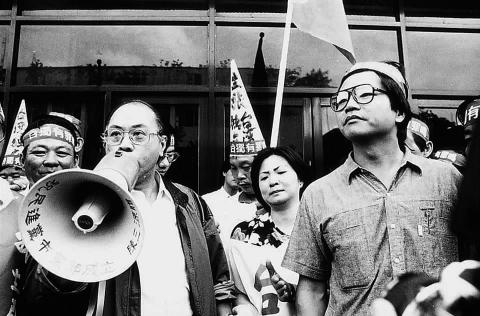
Photo courtesy of Tsai Yu-chuan
Tsai was a graduate of the church’s Tainan Theological College and Seminary. But the church’s involvement with Taiwanese independence dated back to August 1977, when it publicly declared that “Taiwan’s future should be decided by the 17 million residents of Taiwan.”
“To realize the wishes of Taiwanese to be independent and free, we urge the government to face the reality in this precarious international situation and take effective measures to make Taiwan a new and independent country,” the church said.
The church retains its stance to this day, continuing to urge the government through public statements.
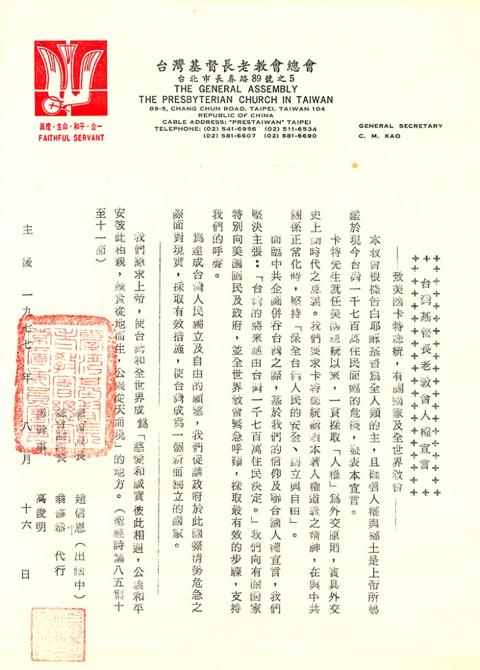
Photo courtesy of Presbyterian Church of Taiwan
THE PIOUS GET POLITICAL
In his memoirs, the late Reverend Kao Chun-ming (高俊明) writes that bad blood between the Chinese Nationalist Party (KMT) and the Presbyterian Church in Taiwan began in the late 1960s, when the World Council of Churches (WCC) started supporting China’s entry to the UN and allowed several Chinese churches to join their organization.
The KMT was not happy, and essentially forced the Presbyterian Church in Taiwan to leave the WCC in 1970, presaging how Taiwan walked out of the UN when China was admitted a year later.
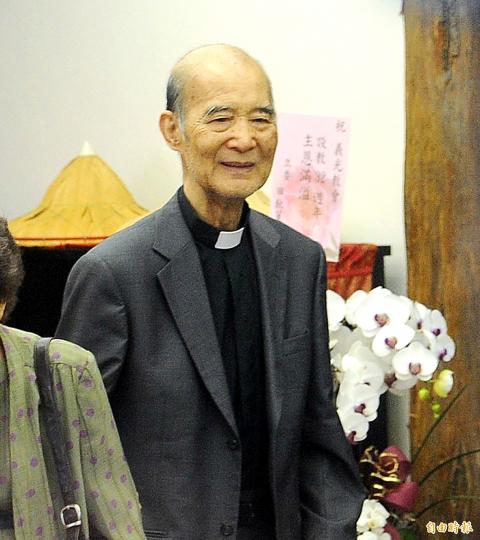
Photo: Fang Pin-chao, Taipei Times
Kao, who took leadership of the church in July 1970, released the first of three public declarations in December 1971.
He criticized the US for “selling out Taiwan” to repressive communist powers and urged the KMT to embrace democracy, so that Taiwan could still be respected by the world despite no longer being a UN member. Taiwanese independence was not yet mentioned; the church merely did not want Taiwan to be swallowed by China after losing its international clout.
“Nobody had spoken out despite our precarious situation, so the church decided that we needed to risk our lives and risk being shut down by the government to express the desires of most Taiwanese,” Kao recalls in his memoirs.
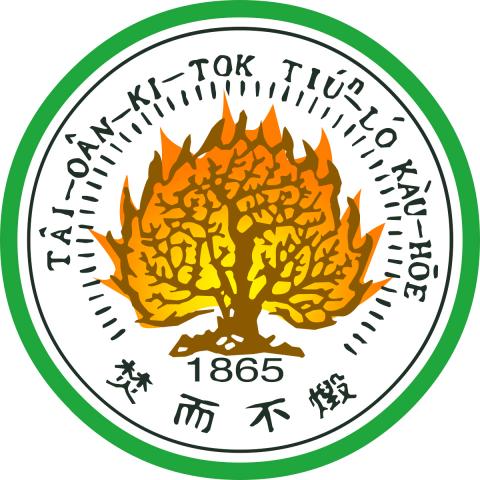
Photo courtesy of Wikimedia Commons
Despite government interference, the church managed to get the message out.
Afterward, Reverend Daniel Beeby of the Tainan Theological College and Seminary was expelled from Taiwan in 1972 for urging his students to embrace independence or risk being conquered by China. To him, the KMT’s insistence on the “one China” policy would only further marginalize Taiwan and lead to its eventual demise. Tsai, a fellow graduate of the seminary, would echo these sentiments in his struggles later on.
In 1975, the KMT confiscated the church’s Hoklo (also known as Taiwanese) Bibles and banned worshipers from singing Hoklo hymns. Coupled with then US President Gerald Ford’s upcoming visit to China, the church decided it was time for a second statement despite grave warnings from the KMT.
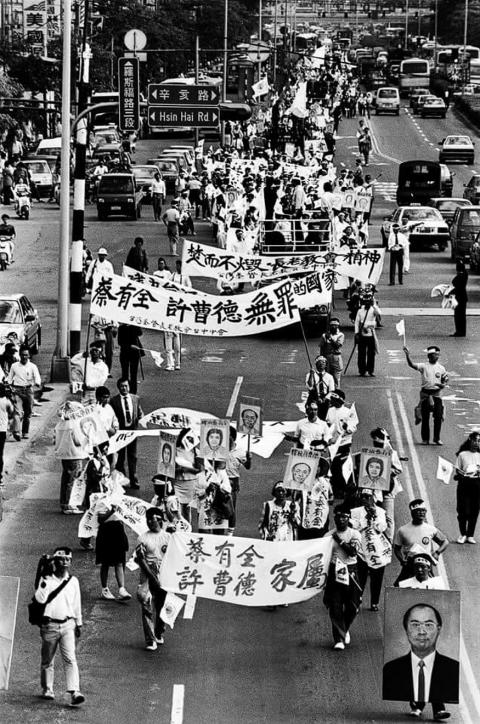
Photo courtesy of Tsai Yu-chuan
This statement was mostly focused on religious freedom, and advised the government to stop banning civic groups from joining international organizations just because they also allowed Chinese membership.
SENT TO JAIL
But Taiwan’s international situation only continued to worsen. By 1977, rumors were swirling that the US was about to break ties with Taiwan for China. Church leaders knew that they would get in trouble for their third statement openly advocating Taiwanese independence, and Kao writes that he and many pastors prepared their wills.
Kao narrowly avoided arrest, despite attempts by the government, probably due to the international clout of the church. But he became a marked man.
During this time, Tsai and other Tainan Theological College and Seminary students grew closer to dangwai (黨外) opposition politicians, with several joining the staff of the anti-KMT Formosa magazine (美麗島).
Tsai was one of several people with ties to the church who were arrested in the aftermath of the Kaohsiung Incident, in which protestors clashed with police at a pro-democracy rally organized by Formosa magazine. He was sentenced to five years in jail.
While Kao was not directly involved, he and several others were arrested a few months later for helping opposition politician Shih Ming-te (施明德) hide from the authorities. Kao served four years in prison.
After martial law was lifted in 1987, Tsai and Hsu immediately helped form the Taiwan Political Victims Association.
Hsu, who was also jailed for several years due to his activism, included the clause “Taiwan should be independent” in the association’s by-laws. And in a speech that same night, Tsai called for Taiwanese independence.
Both were arrested shortly after and sentenced to 10 and 11 years in prison respectively. The church strongly protested, calling for freedom of speech and taking to the streets several times during their trial.
Cheng Mu-chun (鄭睦群) writes in Taiwan Nation: The Presbyterian Church’s National Identity (從大中華到台灣國: 台灣基督教長老會的國家認同及其論述轉換) that despite its 1977 statement, the church tried to distance itself from the independence movement, declaring several times that their words were misinterpreted.
But after Tsai’s arrest and the April 1989 self-immolation of democracy activist Deng Nan-jung (鄭南榕), the church’s official Taiwan Church News (台灣教會公報) newsletter started openly publishing articles supporting independence, confirming the stance that it maintains to this day, Cheng writes.
Taiwan in Time, a column about Taiwan’s history that is published every Sunday, spotlights important or interesting events around the nation that have anniversaries this week.

April 7 to April 13 After spending over two years with the Republic of China (ROC) Army, A-Mei (阿美) boarded a ship in April 1947 bound for Taiwan. But instead of walking on board with his comrades, his roughly 5-tonne body was lifted using a cargo net. He wasn’t the only elephant; A-Lan (阿蘭) and A-Pei (阿沛) were also on board. The trio had been through hell since they’d been captured by the Japanese Army in Myanmar to transport supplies during World War II. The pachyderms were seized by the ROC New 1st Army’s 30th Division in January 1945, serving

The People’s Republic of China (PRC) last week offered us a glimpse of the violence it plans against Taiwan, with two days of blockade drills conducted around the nation and live-fire exercises not far away in the East China Sea. The PRC said it had practiced hitting “simulated targets of key ports and energy facilities.” Taiwan confirmed on Thursday that PRC Coast Guard ships were directed by the its Eastern Theater Command, meaning that they are assumed to be military assets in a confrontation. Because of this, the number of assets available to the PRC navy is far, far bigger

The 1990s were a turbulent time for the Chinese Nationalist Party’s (KMT) patronage factions. For a look at how they formed, check out the March 2 “Deep Dives.” In the boom years of the 1980s and 1990s the factions amassed fortunes from corruption, access to the levers of local government and prime access to property. They also moved into industries like construction and the gravel business, devastating river ecosystems while the governments they controlled looked the other way. By this period, the factions had largely carved out geographical feifdoms in the local jurisdictions the national KMT restrained them to. For example,

The remains of this Japanese-era trail designed to protect the camphor industry make for a scenic day-hike, a fascinating overnight hike or a challenging multi-day adventure Maolin District (茂林) in Kaohsiung is well known for beautiful roadside scenery, waterfalls, the annual butterfly migration and indigenous culture. A lesser known but worthwhile destination here lies along the very top of the valley: the Liugui Security Path (六龜警備道). This relic of the Japanese era once isolated the Maolin valley from the outside world but now serves to draw tourists in. The path originally ran for about 50km, but not all of this trail is still easily walkable. The nicest section for a simple day hike is the heavily trafficked southern section above Maolin and Wanshan (萬山) villages. Remains of